Epinephrine reversed high-concentration bupivacaine-induced inhibition of calcium channels and transient outward potassium current channels, but not on sodium channel in ventricular myocytes of rats
- PMID: 25924894
- PMCID: PMC4422592
- DOI: 10.1186/s12871-015-0049-1
Epinephrine reversed high-concentration bupivacaine-induced inhibition of calcium channels and transient outward potassium current channels, but not on sodium channel in ventricular myocytes of rats
Abstract
Background: Epinephrine is a first-line drug for cardiopulmonary resuscitation, but its efficacy in the treatment of bupivacaine-induced cardiac toxicity is still in question. We hypothesized that epinephrine can reverse cardiac inhibition of bupivacaine by modulating ion flows through the ventricular myocyte membrane channels of rats. The aim of this study was to observe and report the effects of epinephrine on high-concentration bupivacaine-induced inhibition of sodium (INa), L-type calcium (ICa-L), and transient outward potassium (Ito) currents in the ventricular myocytes of rats.
Methods: The ventricular myocytes were isolated from Sprague-Dawley rats (250-300 g) by acute enzymatic dissociation. The whole-cell patch clamp technique was used to record the ion channel currents in single ventricular myocytes both before and after administration of medications.
Result: Administration of bupivacaine 100 μmol/L significantly reduced INa, (P < 0.05). However, administration of bupivacaine 100 μmol/L in conjunction with epinephrine 0.15 μg/ml had no effect in restoring INa to its previous state. Similarly, a sharp decline of ICa-L and Ito was observed after administration of bupivacaine 100 μmol/L (P < 0.05). In contrast to INa, ICa-L and Ito were significantly improved after the administration of the aforementioned combination of bupivacaine and epinephrine (P < 0.05).
Conclusion: Epinephrine can reverse high-concentration bupivacaine induced inhibition of ICa-L and Ito, but not INa. Thus, epinephrine's effectiveness in reversal of bupivacaine-induced cardiac toxicity secondary to sodium channel inhibition may be limited.
Figures
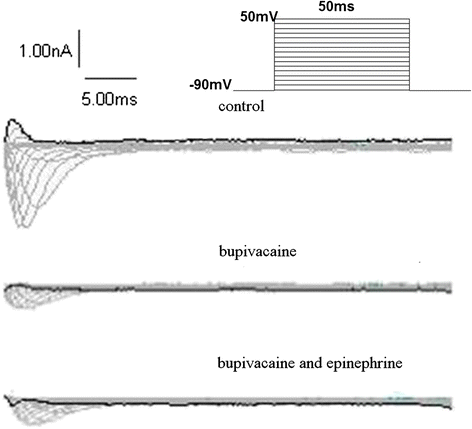
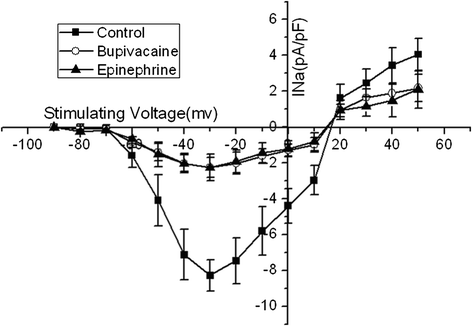
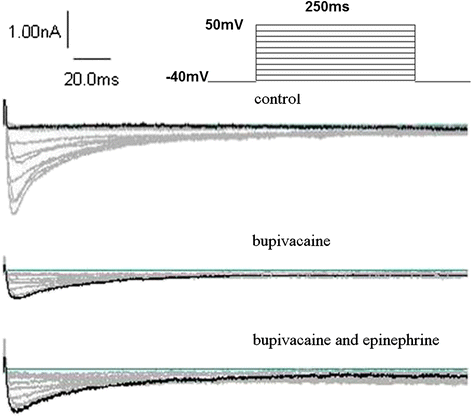
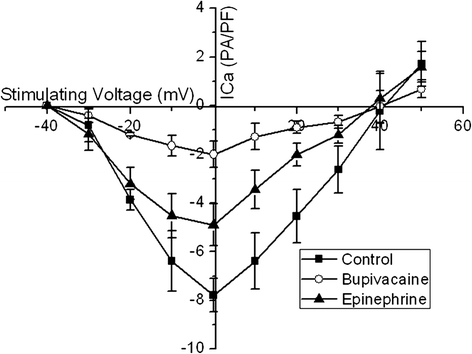
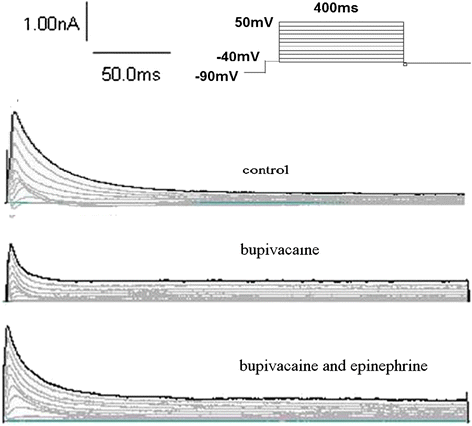
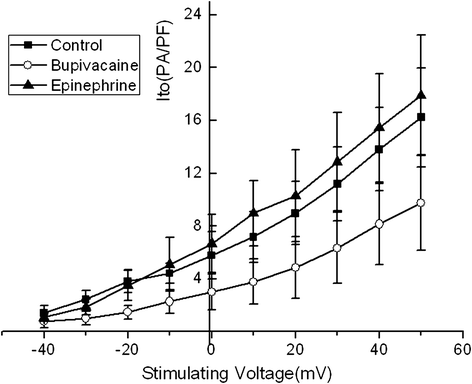
Similar articles
-
[Effects of 4-aminopyridine on calcium currents and sodium currents in guinea pig ventricular myocytes].Yao Xue Xue Bao. 2001 Apr;36(4):250-3. Yao Xue Xue Bao. 2001. PMID: 12580050 Chinese.
-
Electrophysiological Mechanism of Catestatin Antiarrhythmia: Enhancement of Ito, IK, and IK1 and Inhibition of ICa-L in Rat Ventricular Myocytes.J Am Heart Assoc. 2024 Aug 20;13(16):e035415. doi: 10.1161/JAHA.124.035415. Epub 2024 Aug 19. J Am Heart Assoc. 2024. PMID: 39158577 Free PMC article.
-
Lipid rescue reverses the bupivacaine-induced block of the fast Na+ current (INa) in cardiomyocytes of the rat left ventricle.Anesthesiology. 2014 Mar;120(3):724-36. doi: 10.1097/ALN.0b013e3182a66d4d. Anesthesiology. 2014. PMID: 23941864
-
Powerful technique to test selectivity of agents acting on cardiac ion channels: the action potential voltage-clamp.Curr Med Chem. 2011;18(24):3737-56. doi: 10.2174/092986711796642418. Curr Med Chem. 2011. PMID: 21774754 Review.
-
Calcineurin-dependent ion channel regulation in heart.Trends Cardiovasc Med. 2014 Jan;24(1):14-22. doi: 10.1016/j.tcm.2013.05.004. Epub 2013 Jul 1. Trends Cardiovasc Med. 2014. PMID: 23809405 Free PMC article. Review.
Cited by
-
GDF-15 enhances intracellular Ca2+ by increasing Cav1.3 expression in rat cerebellar granule neurons.Biochem J. 2016 Jul 1;473(13):1895-904. doi: 10.1042/BCJ20160362. Epub 2016 Apr 25. Biochem J. 2016. PMID: 27114559 Free PMC article.
-
Modification of distinct ion channels differentially modulates Ca2+ dynamics in primary cultured rat ventricular cardiomyocytes.Sci Rep. 2017 Jan 19;7:40952. doi: 10.1038/srep40952. Sci Rep. 2017. PMID: 28102360 Free PMC article.
References
-
- Heavner JE, Pitkanen MT, Shi B, Rosenberg PH. Resuscitation from bupivacaine-induced asystole in rats: comparison of different cardioactive drugs. Anesth Analg. 1995;80(6):1134–9. - PubMed
Publication types
MeSH terms
Substances
LinkOut - more resources
Full Text Sources
Other Literature Sources
Miscellaneous

